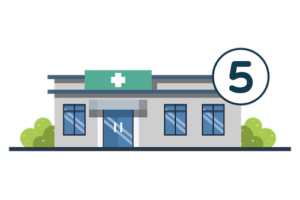2 Smart Scheduling Tactics to Overcome Staffing Shortages and Improve Patient Access
By Chloe From Clearwave | November 15, 2023
A recent report by Experian Health paints a picture of the current state of healthcare access – and it isn’t pretty. The report notes “patient and provider perceptions of access to care are getting worse, not better” – and it goes on to reveal the top paint points for patients related to scheduling. Nearly 78% of patients indicate seeing a doctor/practitioner quickly is a top pain point while 40% say the process of scheduling appointments is becoming more and more of an unwanted hassel.
Practices need to take these access challenges seriously, because – if unaddressed – they can result in patient churn, decreased bookings and missed revenue. In fact, the Experian report found 56% of patients admit they have considered changing providers due to their dissatisfaction in the scheduling process. In today’s uncertain economy, practices can’t afford to lose out; rather, they need to do everything in their power to keep patients coming in.
How are Labor Shortages Impacting Patient Scheduling?
Managing the schedule is becoming a significant challenge for most practices due to the never-ending staffing shortage. The reality is, healthcare practices just don’t have the people-power at the front desk to manage the volume of phone calls coming in, which results in long hold times for patients and slow and inaccurate scheduling processes. Additionally, when practices rely solely on phone scheduling, they lack the real-time visibility to fill appointment gaps with last-minute and same-day appointments – creating lag times between when patients want to see a provider and when they can actually get into the office.
On a recent Clearwave webinar, “The Key to Booking More Patients Than Ever Before,” Jennifer Lott, Director of Operations at The Orthopaedic Group (TOG), talked about these very challenges. She mentioned that her practice, like many others, was struggling with issues related to administrative staff churn. Because they were often short-staffed, patients were experiencing long hold times when trying to schedule an appointment. Additionally, with 26 different providers on staff, each with nuanced scheduling needs, teaching new hires was difficult and training was slowing down the scheduling process. TOG recognized these issues could cause prospective and existing patients to look elsewhere, which would decrease bookings, patient throughput and revenue.
To prevent this from happening, the practice searched for a better approach to streamline scheduling while they dealt with staffing needs. According to Lott, “The goal was to minimize our staff and scheduling struggle by giving patients another option for booking. For us, it was about making it easier for the patients to schedule appointments, while we solve other staffing needs internally.”
TOG found the answer through automation, with smart, patient self-scheduling software.
1. Improve Patient Access with Online Self-Scheduling
Smart, patient self-scheduling software can open up patient access to your practice and address those lingering pain points expressed by patients in the Experian survey – while optimizing the experience for all involved. Here are just a few ways you can put self-scheduling to work for your practice:
- Meet patient demand: According to Experian’s study, 76% of patients want to schedule appointments online or via a mobile device. With patient self-scheduling, practices can meet increasing patient demand for online scheduling to provide a superior experience that drives patient acquisition, retention and overall revenue.
- Provide scheduling flexibility: With self-scheduling, patients have the flexibility to schedule a visit 24/7, in seconds and at a time that is most convenient for them – including after hours and on the weekend. They no longer need to carve out time from their busy day to get ahold of a person live during business hours. Patients also no longer need to hang on the phone for extended periods of time trying to book an appointment slot that works with their schedule.
- Reduce hold times and staff burdens: By offering a second option to book appointments, practices can direct patients to their website, decreasing overall call volume. Not only does this reduce patient hold times, but it also removes part of the scheduling burden from front-office staff.
- Improve scheduling accuracy: With smart scheduling workflows, dermatology practices can meet their providers’ scheduling requirements and their own compliance needs, while giving their patients an easy way to get on the schedule. Additionally, when patients schedule through an online solution, the platform won’t book a patient in a way that strays from provider preferences, no matter how demanding that patient is.
- Fill providers’ schedules: Self-service scheduling maximizes physicians’ schedules by filling their day with a combination of non-urgent and last-minute appointments (we’ll dive into this next).
In addition to experiencing the benefits above, TOG is also driving 84% patient utilization of online scheduling while 16% of appointments booked online are for new patients. Watch the full webinar discussion to hear Lott highlight all the benefits TOG has achieved since implementing online scheduling.
2. Try a Waitlist to Reduce Last-Minute Gaps
High-growth practices are maximizing the return on their self-scheduling investments by complementing the software with an automated patient waitlist. Practices face scheduling gaps every day due to appointment cancellations and rescheduling. While you might not have control over whether a patient cancels or reschedules, you can control how you manage the openings that follow. Adding an automated waitlist to your scheduling strategy can help you quickly and easily fill these last-minute appointment slots.
The waitlist creation process is simple. When a patient is unable to find an appointment time that works with their schedule, they will be given the option to join your practice’s waitlist. As slots open up, due to other patients cancelling or rescheduling, an automatic waitlist will notify whoever is NextUp on the list, going down the line until someone books that available time slot. Upon patient confirmation, the automated waitlist will book the appointment — all without staff intervention.
Automated waitlists are a simple yet highly effective way for practices to fill gaps in the schedule to increase patient throughput, practice efficiency and revenue. Waitlists also help practices improve satisfaction for:
- Patients: When patients can’t find an appointment that fits their schedule, it can cause frustration. Practices can avoid this by offering waitlists that allow patients to find a timeslot that works best with their schedule – helping them feel more at ease and valued by their providers. Additionally, with waitlists, patients can often be seen by their provider faster, because they can grab a last-minute opening rather than waiting for their original appointment time to roll around.
- Staff: An automated patient waitlist tool reduces staff burdens by removing the need to call patients to fill empty appointment slots – freeing them to focus on other administrative activities.
- Providers: Patients aren’t the only ones who experience frustration with scheduling. Providers do, too, when there are gaps in their schedules. Waitlists help you fill those appointment gaps to ensure physicians’ schedules are at max capacity, increasing realized revenue.
Boost Patient Access to Your Practice
Whether you’re short-staffed, experiencing high demand for care or just want to improve scheduling efficiency, patient self-scheduling software in conjunction with an automated waitlist can help you provide the access to your practice that patients demand while driving patient loyalty and revenue.
Find out how Clearwave’s Online Patient Scheduling and NextUp Waitlist solutions can enhance your patients’ self-scheduling experience and reduce staffing burdens.
Recommended for you
Related Posts
Long-Lines Giving You Blurry Vision?
Reading Time: 4 minutes Clearwave & Thomas Eye Group’s 10-Year Partnership Puts Patients First By Blakely Roth | June 18, 2024 In an era…
5 Ways Family Medicine & Primary Care Practices Can Increase Patient Acquisition
Reading Time: 6 minutes By Chloe From Clearwave | June 3, 2024 Family medicine and primary care practices serve as the front line of…
Clearwave Wins ‘Best Patient Registration & Scheduling Solution’ in 2024 MedTech Breakthrough Awards
Reading Time: 2 minutes ATLANTA – May 23, 2024 – Clearwave today announced it has been named the “Best Patient Registration and Scheduling Solution”…




